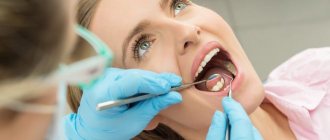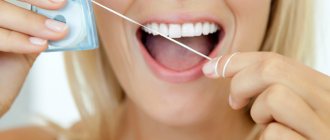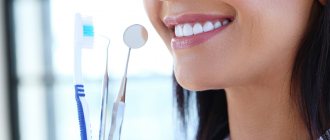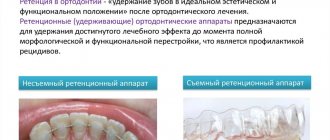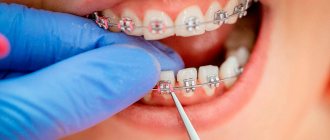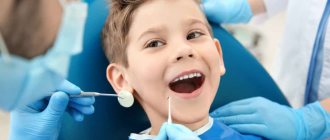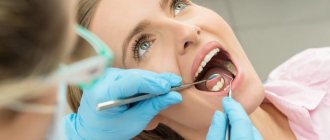Cleaning before braces: why is it needed?
Correction of the bite always begins with sanitation of the oral cavity. In addition to treating diseases of the teeth and gums, it includes mandatory professional cleaning before installing braces. The doctor will remove hard deposits with ultrasound, and soft deposits with a thin and powerful jet of cleaning powder solution (AirFlow technology). After this, the teeth will need to be polished with a special paste and coated with a fluoride-containing preparation to strengthen the enamel. Such a hygienic procedure should be carried out 3 - 5 days before installation, but no later than 24 hours.
What happens if you don’t brush your teeth before braces? Bacterial plaque will get under the elements of the system, in particular under the clasps that are glued to the enamel. Considering that orthodontic appliances are worn for a year at best, and two years on average, microorganisms will have enough time to multiply and lead to the formation of caries. It is impossible to properly cure it with braces on the teeth. There is a risk of early removal of the device, and this will spoil the final result, and the patient will waste money, time and moral strength. This is why brushing your teeth before getting braces is mandatory.
Professional teeth cleaning while wearing braces helps:
- remove plaque and tartar from enamel
- remove stains caused by food dyes or bad habits
- gain beautiful natural tooth color and smooth enamel
- strengthen the enamel
- reduce the risk of developing caries and inflammatory processes in periodontal tissues
- Provide fresh breath for a long time.
Direction: Occupational hygiene and whitening
Professional hygiene with braces.
Doctor: Sklyarov Konstantin
Rules for caring for braces after installation
And finally, the orthodontic structure is put on. There are many months, or even years of treatment ahead, during which you will need to devote a lot of time to oral hygiene. Cleaning braces is not an easy task. An orthodontic apparatus is a complex system with many elements: clasps, arches, ligatures, rings, springs, hooks for elastic rods... And on each of them food particles can remain and plaque can accumulate.
Recommendations for caring for the braces system
- You need to brush your teeth at least three times a day, and ideally after every meal, even a small snack.
- It is necessary to brush not only your teeth, but also between them. Dental floss will help clean the interdental space.
- The hygiene of braces must be the most thorough: all elements of the system will have to be processed on each side, avoiding the accumulation of plaque.
- You will have to purchase special brushes for cleaning braces, as well as additional devices such as an irrigator. We will talk about this in more detail below.
- To clean the braces system and teeth, a fluoride-containing paste is used, as well as a fluoride-containing rinse, which completes the oral hygiene procedure with braces.
- It’s best to always carry a toothbrush and floss with you in case you need to eat out.
- For those who wear braces, care and nutrition go hand in hand. During treatment, you will have to give up a number of foods—hard, sticky, fibrous, and anything else that could damage your braces or get stuck in them. You should also significantly limit sweets.
Hygiene of the brace system is a key task for the entire period of wearing an orthodontic device. If it is neglected, whitish spots may appear on the enamel of the teeth - traces of demineralization and the accumulation of bacterial plaque. They look unaesthetic and spoil the impression of the results of long-term treatment.
WHY DO YOU NEED PROFESSIONAL TEETH CLEANING WHILE WEARING BRACES?
Professional oral hygiene is the main way to prevent diseases of teeth and gums. During orthodontic treatment, home hygiene is significantly more difficult. Even with high-quality care, it is difficult to achieve effective cleaning of teeth, braces, chains, arches, elastic bands, etc.
PROFESSIONAL TEETH CLEANING WHEN WEARING BRACES HELPS:
- remove plaque and tartar from enamel
- remove stains caused by food dyes or bad habits
- gain beautiful natural tooth color and smooth enamel
- strengthen the enamel
- reduce the risk of developing caries and inflammatory processes in periodontal tissues
- Provide fresh breath for a long time.
STEPS OF PROFESSIONAL HYGIENE WHEN WEARING BRACES
- Before carrying out professional hygiene, we make sure to remove all arches, ligatures, elastic bands, etc. to provide access to interdental contacts. They are the first to suffer during orthodontic treatment.
- Tartar removal. The procedure is carried out with special ultrasonic scalers. Using slight vibration, they will remove hard deposits from all tooth surfaces and braces.
- Removing dense pigmented plaque - Air Flow. The device uses pressure to spray a mixture of water and cleaning powder onto your teeth, which will remove plaque without damaging the enamel. Air Flow brushing also has a brightening effect - teeth become one or two shades whiter.
- Polishing teeth with special pastes with different flavors. The smooth surface of the teeth prevents the formation of plaque, and therefore reduces the risk of developing caries.
- Fluoridation and remotherapy. If plaque remains on the teeth for a long time, the mineralization of the enamel decreases - this can lead to caries. Therefore, the mandatory final stage of professional hygiene during orthodontic treatment is strengthening the enamel.
- After completing the hygiene, we will fix all parts of the bracket system in their original places.
And finally, the dentist will select home hygiene products for you, show you how best to clean the locks of your braces, and how to deal with hard-to-reach places. The doctor will also draw up a personal schedule of hygiene procedures for the entire period of wearing braces.
HOW OFTEN IS PROFESSIONAL HYGIENE NEEDED DURING ORTHODONTIC TREATMENT?
With high-quality home care, professional hygiene is recommended for adults:
- at least once every 4 months when wearing mouth guards or vestibular system
- at least once every 2 months with lingual braces.
The occupational hygiene schedule for teenagers is selected individually, since not all children approach home hygiene responsibly.
EDUCATIONAL TEETH CLEANING: WHY IS IT NEEDED AND HOW IS IT DONE?
Our hygienists provide educational and supervised dental cleanings for those wearing braces. We help patients learn good hygiene skills to effectively remove plaque at home.
- We apply a product to the teeth that stains plaque. We show the patient in which places hygiene is worse.
- We provide an individual brush, and the patient brushes his teeth himself under the supervision of a specialist.
- We evaluate the result and show the patient the places where plaque remains.
- The hygienist teaches the correct technique of brushing teeth on models, gives recommendations on brushing techniques, teaches how to use dental floss, special toothbrushes, monotuft brushes, dental brushes, irrigators, etc.
Hygiene products for braces
When a person wears braces, oral care consists of several stages. Each of them has its own tool, so the patient will have to acquire a whole arsenal of hygiene products.
Brush for cleaning teeth with braces
The orthobrush has a V-shape with a depression in the center of the pile, which is necessary for treating the surfaces of teeth and most of the orthodontic apparatus. This is where teeth cleaning with braces at home begins. Orthodontists also recommend purchasing a single-tuft toothbrush for cleaning braces. It will be useful for processing distant teeth and the outer part of locks.
Brushes for cleaning braces
It is also necessary to use brushes to clean braces. With their help, it is easy to clean the dental surface under the arcs of the device.
Superfloss
For oral hygiene with braces and cleaning the space between the teeth and around the clasps, you will need a special thread with a hard end - superfloss.
Oral irrigator
Separately, it is necessary to mention the most important device for cleaning braces - the irrigator. The device is somewhat similar to an electric toothbrush, but instead of bristles it has a nozzle from which a powerful stream of water is supplied. The irrigator helps clear plaque from hard-to-reach places where brushes and brushes cannot reach (for example, gum pockets).
Strengthening toothpaste
Wearing braces significantly increases the risk of caries. Therefore, it is worth thinking about prevention. Toothpastes with fluoride, hydroxyapatite crystals, theobromine and other strengthening substances will make your teeth stronger.
Professional hygiene in our clinic. TOP 7 advantages:
1. We take the procedure as seriously as we treat dental treatment! Occupational hygiene is carried out only by certified specialists with extensive experience.
2. Always individual selection of methods, means and materials. We initially take into account all your characteristics (increased sensitivity of teeth, inflammatory diseases of periodontal tissues, the presence of installed implants, etc.) and carry out professional hygiene with high quality and accuracy.
3. To remove dental plaque, we use a special powder that does not change the structure of the enamel in any way!
4. Our doctors use plaque indicators to visually control the quality of cleaning of all tooth surfaces.
5. The cost of professional hygiene already includes fluoridation and remotherapy (enamel strengthening).
6. If you are afraid of any dental procedures, we can perform professional hygiene under sedation (with nitrous oxide).
7. We will teach you proper home hygiene. We will select care products for you based on your needs. We will teach you how to effectively use electric or manual brushes. We will select brushes and dental floss, and teach you how to clean the contact surfaces of teeth.
Why do you need to have your braces cleaned at the dentist?
No matter how thoroughly you clean your braces at home, it is impossible to 100% remove plaque accumulated in hard-to-reach places. This is why patients undergoing orthodontic treatment are recommended to have their braces professionally cleaned at least once every 6 months, and ideally once every quarter. It needs to be scheduled in the same way as regular visits to the orthodontist to monitor and correct the system.
Professional cleaning of teeth with braces is carried out according to the same scheme as in all other cases, but requires greater care from the doctor. Using the AirFlow device, the hygienist removes plaque, paying special attention to the areas around the locks. If necessary, ultrasound is also used to remove hard deposits in the pregingival zone (ultrasound cannot be used around elements of the orthodontic apparatus). After completing the procedure, it is worth carrying out surface fluoridation of the teeth to strengthen the enamel.
Professional hygiene will help avoid the appearance of whitish spots on the surface of the teeth. Therefore, to the question “Is it possible to do cleaning with braces?” we answer: “Not only is it possible, but it is also necessary!”
Why do you need professional teeth cleaning during orthodontic treatment?
Professional hygiene is the main way to prevent dental diseases. During orthodontic treatment, home hygiene is significantly more difficult. Even with high-quality care, it is difficult to achieve effective cleaning of teeth, braces, chains, arches, elastic bands, etc.
Brushing your teeth after removing braces
You need to be attentive to oral hygiene not only during orthodontic treatment, but also after its completion. Care after removing braces plays an important role in preventing caries. The fact is that during the process of correcting the bite, the enamel is subjected to constant pressure. Dental care after braces often includes the use of special gels, pastes and varnishes that restore enamel density and reduce sensitivity.
Professional cleaning after braces will also not be superfluous. The hygienist will remove plaque and pigment inclusions and make an application that strengthens the enamel. If there are no contraindications, after removal of the system, patients can have their teeth whitened to return them to their original snow-white shade.
Brushing your teeth after braces at home should remain just as thorough. Of course, there will no longer be a need for a whole arsenal of brushes and brushes, but brushing your teeth twice a day and using floss is a must.
Why is it so important to brush your teeth?
A malocclusion almost always means that a person has hard-to-reach areas in the oral cavity. They accumulate a large amount of plaque and small particles of food, which can be difficult to clean with a regular brush. Also, the braces themselves hinder proper care, because dirt can also get under the parts of the structure.
For home care, modern manufacturers produce special orthodontic brushes; their bristles have different lengths and shapes; they can have several or one tuft of bristles. Additionally, you can purchase small brushes, an irrigator for treating the oral cavity with strong pressure of liquid, and much more.
However, no home care can compare with professional cleaning in the dental hygienist’s chair. It should be carried out at least once every two to three months, this will help reduce the risk of tartar and enamel caries. Today, there are several methods of safe cleansing, each of which is suitable for patients with and without braces.
What can't you eat if you have braces on your teeth?
If you have braces, regardless of the model, you must follow a certain diet. It mainly concerns solid and sticky products that can stick to structural elements and lead to breakdown of the entire system. These include chewing gum, seeds and nuts, crackers and dryers, and caramel candies.
Excessively cold or hot foods/drinks, ice cream, as well as tea, coffee, juices, and “coloring” fruits should be excluded from the diet - some models of plastic, ceramic and sapphire braces, as well as ligatures (rubber bands) are susceptible to staining.
